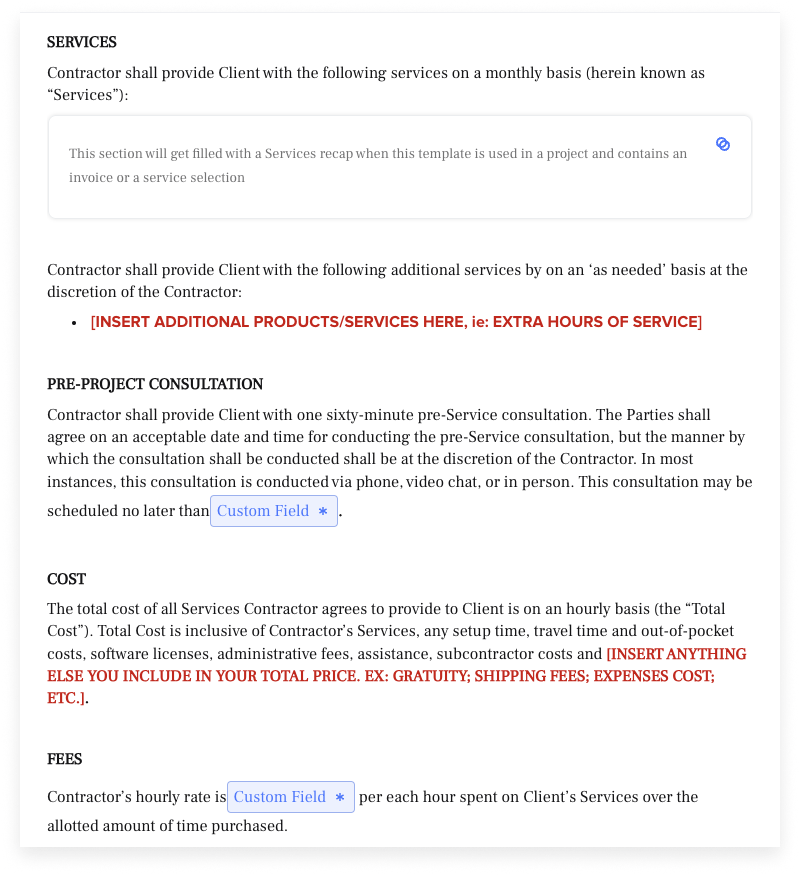Creating a clear and comprehensive scope of work (SOW) is essential for setting expectations and ensuring a successful project outcome. In this article, we’ll guide you through the step-by-step process of creating a SOW that outlines every detail of your project, from tasks and timelines to deliverables and costs.
A scope of work thoroughly describes exactly what you are going to do for your client. The scope lists each part of your service as well as the materials used for the job, the steps you’ll take to complete it, the timeline, and the full responsibilities of each party involved in the project.
A good scope leaves no question about what you are being paid to do and how you are going to do it. It should set the expectations for everyone, showing your client what they’ll receive and when. It can be used as a reference in the rare case of disputes afterward. It can also help you to do a good job for your client so you get repeat business.
Jump to:
- What is a scope of work and why is it important?
- Scope of work vs Statement of work
- How to write a scope of work
- What does a scope of work look like?
- What can happen without a scope of work?
- Scope of work best practices
- How to stick to your scope of work
- How to use an all-in-one clientflow platform to send proposals and contracts
What is a scope of work and why is it important?
A scope of work is a document or a clause in a contract that describes what a service provider will complete within a project. Independent businesses can use SOWs to fully describe their work in a service proposal or similar document for their clients. The scope of the project defines the boundaries and deliverables of the project, including what will be done, the tasks involved, timelines, and resources required. It sets clear expectations for both the project team and stakeholders.
As part of your sales process, you can use detailed scopes in your proposals to show clients exactly what they can expect to see in the project. Seeing these details laid out in a document can help assure the client and make them feel more confident about moving forward and booking with you.
You can also include the project budget in your SOW, which the client can use for budgeting purposes. Finally, scopes can communicate to clients when they can expect the results of the job.
Once you have a contract with a client, a scope sets the expectations of all parties so there are no surprises. The client can see the project planning in detail. The SOW should detail what will be completed and when. At the same time, you have a plan of action written down that you can easily follow to get the job done.
Pro tip
Be very specific and detailed in your scope so your client is fully informed. Leave no question about how exactly you are going to do the project and when the results will be delivered.
Scope of work vs statement of work vs work order
The scope of work, statement of work, and work order are crucial documents that help define project parameters and expectations. Although they are sometimes used interchangeably, they serve different purposes and offer varying levels of detail.
A scope of work is a detailed description of what a service provider will complete within a project. It is often included in service proposals to help clients understand the specifics of the project. This document can include tasks, deliverables, timelines, and responsibilities, providing a clear picture of what the client can expect. By outlining the project in detail, a scope of work helps assure the client and builds confidence in the service provider’s ability to deliver.
A statement of work, on the other hand, is a broader document that encompasses the entire project, including the scope of work. It provides a comprehensive overview of the project, including objectives, deliverables, timelines, and success criteria. The statement of work is typically used in formal contracts and serves as a reference point for all parties involved. It sets the foundation for the project, ensuring that everyone is on the same page and understands their roles and responsibilities.
A work order is a document that authorizes specific tasks or services within a project. Unlike a scope of work, which details overall project parameters and expectations, and a statement of work, which provides a comprehensive overview, a work order focuses on individual tasks with precise instructions, deadlines, and responsibilities.
For example, in a scope of work, you might see, “Develop a mobile app for online shopping by December 2025.” A statement of work could be, “Create a user-friendly mobile app to increase sales by 20% within six months.” A work order might read, “Complete the app’s login functionality by July 10th.” This work order document can be crucial for operational control, allowing for detailed management and execution of specific project components when applicable.
By using these types of documents, service providers can enhance communication, reduce misunderstandings, and increase the likelihood of successful project outcomes.
How to write a scope of work
Writing a scope of work involves detailing the essential elements of a project to ensure clarity and alignment among all stakeholders. Understanding how to write a scope of work involves knowing what to include to ensure clear communication and project success. Here’s how to effectively craft your SOW step-by-step:
1. Title your project
Start with a clear, descriptive title that accurately reflects the nature of the project. This helps set the context and provides a quick reference.
2. Identify stakeholders
Identify all stakeholders, including yourself, the client, and any additional vendors or team members. Clearly define each party’s roles and responsibilities to ensure accountability and understanding.
3. Define project objectives
Outline the project’s goals and objectives. Describe the problem you aim to solve and how your services will provide a solution. This gives a clear purpose and direction for the project.
4. List tasks
Break down the project into specific tasks. Detail each step required to complete the project, ensuring that all actions are clear and manageable. This task list serves as a roadmap for project execution.
5. Set a timeline
Establish a timeline for the project. Include start and end dates for each task, as well as the overall project deadline. Mention any milestones and their required approvals to keep the project on track and ensure timely completion.
6. Detail deliverables
Clearly specify the deliverables that will be provided upon project completion. Detail the components or outputs that the client can expect to receive, ensuring they understand the scope of what is being delivered.
7. Outline costs
Include a detailed budget that outlines all project-related expenses and fees. This should cover labor, materials, and any other costs that may be incurred. Transparency in budgeting helps manage client expectations and prevents financial misunderstandings.
What does a scope of work look like?
Your contracts or proposals may not always look the same, but there will likely be some common elements. These include a scope clause among other common contract clauses. Your scope should appear early in your contract after the basic details of the parties.
Example scope
This scope is for a fictional graphic design business.
Title: Designing a new logo, one website banner image, and one advertising background image for [Your Client]
Parties:
[Your Name],
[Your Partner],
[Your Subcontractors, if any],
[Your Client’s Name]
Project objectives:
To complete a new logo for [Your Client] and design new branding elements such as choosing a brand style with new colors and fonts on website images and advertising.
By the end of the project, [Your Client] will have a new logo and one website banner image that will get attention on [Your Client’s] website and packaging and one image for advertising that will get them noticed in today’s crowded market and stand out in social media content and ads.
All images can go through one revision each before final approval.
List of tasks:
- Logo redesign
- Website banner image
- Advertising background image
Timeline:
- The logo redesign abstract by June 1, 2023
- The logo’s final draft will be submitted for approval on June 10, 2023
- The logo will be completed on June 20, 2023
- The banner image for the website abstract by June 2, 2023
- The banner image final draft will be submitted for approval on June 11, 2023
- The banner image will be completed on June 21, 2023
- The ad image abstract will be done by June 3, 2023
- The ad image final draft will be submitted for approval on June 12, 2023
- The ad image will be completed on June 22, 2023
- All images emailed to the client by July 5, 2023
Deliverables:
After approval, the logo and images will each be delivered as PNG files and SVG vector files in a zipped folder via email by July 5, 2023.
Costs:
All costs incurred by [Your Name] are built into the overall price of the project.
What can happen without a scope of work?
Imagine a construction project where contractors are trying to build a house without a blueprint or individual tasks. No one would know where to start or how to price out the cost of the house.
The same is true if you try completing a project without first outlining your schedule, expectations, and boundaries.
One of the biggest risks is scope creep. Scope creep is what happens when there’s no system in place for sticking to the initial scope of a project. Expectations tend to get larger and larger until a once-achievable project becomes a monumental task. As a result of scope creep, project managers may find:
- It’s impossible to meet agreed-upon deadlines because of egregious project schedule expansion, or they have to work overtime to meet deadlines
- Customers are dissatisfied with the work produced because they expect more
- They may have to charge clients more money than initially quoted, which risks alienating the clients, or make less money per hour worked than originally intended
To avoid scope creep, clearly define the project scope at the beginning, maintain strict change control processes, and regularly communicate with stakeholders to manage expectations.
Your scope of work also ensures everyone is on the same page about project expectations and payment terms. For example, a freelance writer might charge clients per word written. However, a project scope would outline things like:
- Whether they are charging for the exact number of words written (1043 words) or for a range of words (900-1100 words, for example)
- Whether they count the words before or after any edits
- Whether there are any edits included, and if so, how many
Having clear project boundaries allows your team to knock client expectations out of the water while managing time effectively.
Scope of work best practices
Knowing how to write a scope of work effectively is essential for delivering successful projects. Best practices play a vital role in creating a clear, concise, and comprehensive document that sets the stage for smooth execution and collaboration. Here are some best practices and tips to help you craft an effective SOW:
- Be specific: Clearly define every aspect of the project. Avoid vague descriptions and ensure every task is detailed.
- Use clear language: Write in simple, straightforward language to avoid misunderstandings. Technical jargon should be minimized unless necessary.
- Include visuals: Use charts, diagrams, and timelines to illustrate project plans and milestones. Visual aids can help clarify complex information.
- Collaborate with stakeholders: Involve all relevant parties in the creation of the SOW. This ensures that everyone’s expectations and responsibilities are clear from the outset.
- Regularly review and update: Projects can evolve. Regularly review the SOW and update it as needed to reflect any changes in scope or objectives.
- Start with a template: Using a template can ensure you don’t miss any crucial sections.
- Set realistic timelines: Avoid overly optimistic deadlines. Allow buffer time for unexpected delays.
- Define success metrics: Clearly state how success will be measured. This can include completion dates, quality standards, and budget adherence.
- Include contingency plans: Outline potential risks and how they will be managed. This prepares the team for possible challenges.
- Get formal approval: Ensure the SOW is formally approved by all stakeholders before project commencement. This formal agreement helps avoid disputes later.
By following these best practices and tips, you can create a Scope of Work that sets clear expectations, facilitates smooth project execution, and minimizes risks. This structured approach helps in achieving project goals efficiently and effectively.
How to stick to your scope of work
Once you know how to write a scope of work, the next step is knowing how to stick to it. This means being firm about holding yourself and your clients accountable for the agreed-upon tasks.
Holding yourself accountable to your scope of work
Once you have your scope of work, you are responsible for keeping the project moving — and that starts with keeping yourself on task.
Start by outlining how long each project milestone will take you to complete. Remember to include a buffer window of about 20% of the length of the milestone. For example, if the first leg of the project will take you about five days to complete, give yourself six days. If the first leg of a project will take you about a month, give yourself a month and a week. This buffer time helps ensure you meet your deadlines, even when unexpected barriers pop up.
Once you know how long each milestone will take you, use project management software to set up your timeline and create task reminders to keep yourself and your team on track. A good rule of thumb is to consider three reminders for key milestones: one when you’re supposed to start the task, one about halfway through the task so you can evaluate your progress, and one on the day the task is due.
Pro tip
With HoneyBook, you can keep track of your project status at a glance and set up automated task reminders to make sure nothing slips through the cracks.
Holding clients accountable to the scope of work
One of the most efficient ways to hold clients accountable for their portion of a scope of work is by including a written clause in your contract outlining the consequences of clients being late on their contribution.
For example, if a client is supposed to provide you with information by a certain date and fails to do so, are you still expected to complete your portion of the project within the initial time frame?
One option is to frame your contract so you always have the same amount of time to do work. For example, you might create project milestones, and instead of giving a particular date by which you’ll complete the milestone, you could instead say, “Within 3 business days of receiving X from the client.” This makes it clear that your ability to stick to your initial deadlines is contingent on the client sticking to theirs as well.
Another option is to incorporate fees into your project scope. This way, the client knows that, while you’re willing to stick to your initial schedule, you may have to charge extra for your time if their inability to meet deadlines forces you to work late.
Regardless of which way you choose to hold your clients accountable, it can be a good idea to set up automated email reminders when client deadlines are approaching. This pairs well with other established boundaries and shows you’re willing to take initiative while still holding them accountable to their commitments to you.
How to use an all-in-one clientflow platform to send proposals and contracts
Ironclad contracts need to be clear and thorough. You don’t want your client scratching their head about what you’re going to do for them. One section of the contract that must be especially detailed, organized, and clear is the scope section. Scopes lay out the services that you are offering and the project details.
Scopes help your client because they get to see a detailed outline of every part of the job they are paying for. And a good scope helps you stay organized and on schedule.
With an effective scope, you and your clients can feel confident that you’ll end up with a successful project. You can count on a more organized workflow, less difficulty when working with clients, and a great client experience overall.
When your client hires you, send them proposals and legally binding contracts with online software such as HoneyBook. When they can sign the contract, you will get notified so you can start working right away. Then use HoneyBook to send invoices and accept payments. It’s super convenient for everyone!







